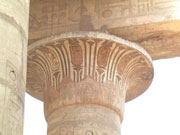TOUR NEWS - EASTERN TURKEY SEPTEMBER 2013
It was with a great deal of excitement that B.C. Archaeology ran its inaugural trip through eastern Turkey. The tour left Australia on the 31st August and returned to Australia on the 22nd September 2013. The tour group was almost a reunion of 'regulars' and included: Margaret Debenham, Veronica McKervey, Nola Thompson, Catherine Doherty, Alex Radford, Jan and Tom Lockley, Sandra Gillespie, Deborah Russell, Rachel Hole, Helen Fletcher and Catherine Fitzgibbon. The tour was accompanied by our excellent local Turkish guide Sevil Yalcin who really went out of her way to make our trip run smoothly, and our driver was Muzafar. The tour was led by the author Michael Birrell.
I went ahead of the main tour group (together with Catherine, Nola and Rachel) to get over jetlag and enjoy a few days exploring the many wonderful sights of Istanbul. We stayed in Sultanahmet at the Artefes Hotel which has very beautiful views over the Bosphorus from the roof terrace. We had 3 days before the group arrived. I went to the archaeological Museum which had a new display of the wonderful finds from the Yenikapi excavations of the Byznatine harbour of Theodosius - they have now discovered 35 shipwrecks and part of the finds are on display. Much of the rest of the museum is getting a major makeover with most galleries closed. We also went to the Blue Mosque and down to the Golden Horn where we stopped in to see the Railway Station where the Orient Express used to terminate.
The rest of the group arrived on Sunday the 1st September. Sevil and I went out to collect the group and bring them back to the hotel for a freshen up. We then went out towards the ancient walls of Istanbul where we saw the Ottoman fortress called Yedikule, built in the 15th Century by Mehmet the Conqueror. We also went to see the mosaics and frescoes in the Chora Church, splendid works of art from the Palealogian revival of the 14th Century. We had some lunch in the caf� overlooking the church. We then headed to the Mosque Complex of Suleyman the Magnificent - this is a wonderful building in the heart of old Istanbul.
 |
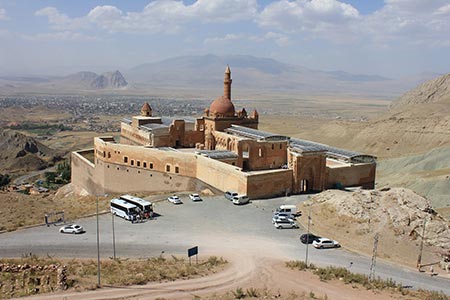 |
The walls of Ani |
Ishak Pasha Castle at Dogubeyazit |
The next day we packed up and headed to Sabiha Gokcen Airport for our flight to Kars - our trip took us across the Bosphorus bridge with superb views looking back to Topkapi. Our flight was very smooth and we were met by our driver Muzafa and taken to our hotel. We had some lunch at a restaurant across the road - we sat out on the footpath. The city of Kars has a frontier feel with old black-stone houses from the days of Russian rule in the late 19th Century but there is lots of new building. We went to see the Church of the Holy Apostles, a 10th Century Armenian church in the old quarter. Some of us climbed up to Kars Castle for a view over the city - we encountered a bride and groom who wanted to be photographed. After dinner we went to taste some cheese (Kars is famous for its goats cheese) and also tasted some eastern Turkey wines.
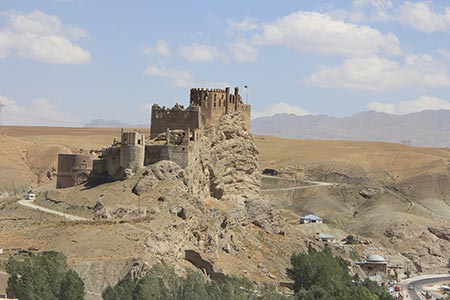 |
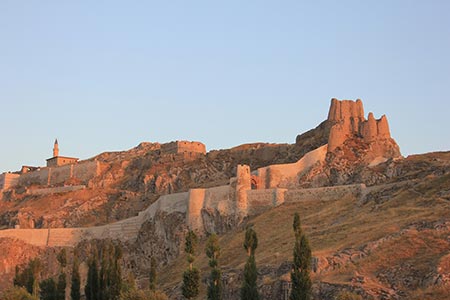 |
Hosap Castle |
Van Castle |
On the 3rd September we headed east through broad grasslands to visit the ruins of the ancient Armenians capital Ani, located on the border of modern Turkey. The walls of the ancient city are very impressive and we spent the day exploring the ruins of the old churches. A few of us climbed up to see the citadel with the ruins of the royal palace. We largely had the site to ourselves - lunch was in the local restaurant. We stayed overnight in Kars and then the following day drove southwards through the dramatic volcanic landscape. There was still some snow on the summit of Mt Ararat which we saw very clearly (it is often in mist). We had a picnic lunch in a camp ground where we fed the chooks. After lunch we saw the superb Ishak Pasha Palace near Dogubeyazit, a magnificent 18th Century palace overlooking the pass which leads to Iran. A major restoration program has seen the roof repaired. We also stopped to see the more ancient castle and Urartian inscriptions (8th Century BC). Our journey south took us to the Muradiya waterfall where we had some tea. It was dark by the time we checked into our hotel on Lake Van.
The following day we headed inland to the SE of Van to see some of the ancient sites on the road towards Iran. We went to see the ruins of the Iron Age Urartian Palace at Cavustepe. We were fortunate to encounter Mehmet Kushman, the caretaker, who talked about his involvement in the excavations of the palace. He also reads Urartian cuneiform and explained the language to us. The palace is extensive and includes two temples as well as the storerooms and the ancient throne room (or I should say the royal toilet!). We continued on our road, stopping to visit the splendid 17th Century Ottoman castle at Hosap. We had a picnic lunch by the riverside (Turkish meatballs and fresh bread) and then explored the castle ruins. We met the local Turkish archaeological team and were lucky to have the director give us a guided walk around the recent work. Back at the hotel we had a pleasant fish dinner in our hotel near the lake.
The following morning we drove along the shore of Lake Van and then went by boat over to Ahdamar Island - it was a perfect sunny morning. The Church of the Holy Cross was built in 921 and was part of a royal complex which included a palace. The relief carvings on the outer surface, and the bright fresco paintings inside consist of subject from the Old and New Testaments. We met a group of Iranian tourists. We then drove back to Van, stopping en route to see an early Turkish tomb, and went to see a Carpet Shop. They had some Van cats (a special breed with one blue and one green eye) which we all gave pats to. We had some lunch in the town and then in the afternoon went down to the shore of Lake Van to see Van Castle which is perched on a massive rock. We walked round the southern edge of the rock to see the inscription of Persian King Xerxes and then climbed up to see the Tomb of the Urartian King Argishthi I - a rock cut chamber with extensive autobiographical text carved in cuneiform text. We clambered over some rocks to get a good view of the Ottoman Castle in the light of the sunset. Margaret, Helen and I also had a look at a few other Urartian inscriptions by climbing under some barbed wire!
 |
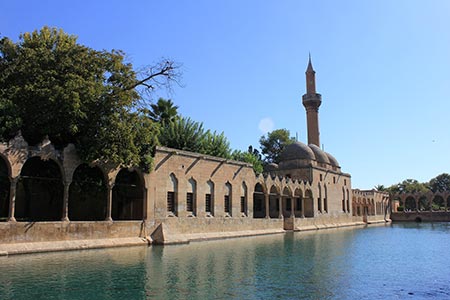 |
The walls of Diyarbakir |
The pools of Abraham in Sanliurfa |
On the 7th September we had our last breakfast on the lake edge and then headed west and south. We were heading towards Diyarbakir - when I suggested we drive to the top of Nemrut Dag volcano on the western shore of Lake Van there was some excitement. Our driver Muzafar was somewhat disconcerted but we eventually made our way to the rim of the volcano (the road was being 'upgraded') and then descended to one of the 3 main crater lakes. We eventually got back on the road, stopping to see an Ottoman caravanserai and an Artuqid (early Turkish) bridge before arriving in our destination.
Diyarbakir is dramatically located overlooking the Tigris River. We ascended part of the ancient walls for a grand view over the city and went for a walk in the historic quarter. We visited a Syrian Orthodox Church where they still use Aramaic in the service, saw the ancient bridge across the Tigris, had a cup of tea in an Ottoman Han (caravanserai), saw some of the ancient markets and had an atmospheric lunch in the Hasan Pasha Han. In the afternoon we saw the Armenian Orthodox Church which had recently been reconstructed, drank some menenjich (coffee substitute) in a local caf�, and explored the historic Great Mosque dating from 1091. A rich and exotic day!
Our road then took us westwards through flat desolate country. We stopped to have a coffee under some trees in one small town and watched some children herding sheep down the main street. Our journey led us past a number of ancient �tell� sites, remnants of ancient settlements. We drove to Gobekli Tepe to explore the pre-Neolithic stone temples. The oldest man made religious buildings in the world, they preserve fascinating relief scenes of totemic animals. We checked into our hotel in Sanliurfa (ancient Edessa). The following day (10th September) we explored the shrines of Abraham where we met some Syrian refugees and bought them some lunch - they spoke no Turkish and I felt they had very little understanding of how they could get help from the authorities. We went for a walk in the ancient markets where Rachel tried on the local purple scarf - very fetching! We had some coffee in a mediaeval han (Gumruk Hani) and then headed south to visit Sultantepe, an ancient tell which sits on the edge of the Syrian plain. We also saw the small museum of Urfa where artefacts from the local sites are housed.
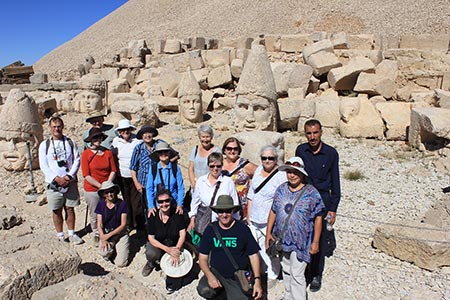 |
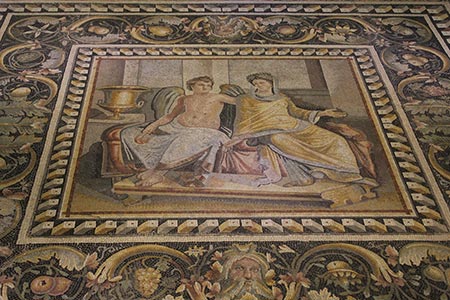 |
Exploring Nemrut Dagi |
Roman mosaic in Gaziantep |
We left Urfa, heading north to the impressive Ataturk dam on the Euphrates River. It was pleasant to have a cup of tea and to think about the history of this fascinating area. Our road took us past a Syrian refugee camp - many of the refugees have come from Aleppo which is not far to the south. We then headed up the Euphrates valley to visit the antiquities of Commagene. An ancient Kingdom which developed during the Hellenistic Period, it is famous for the stunning temples built by King Antiochus I on Nemrut Dag. We ascended the path, rejecting the proffered donkey ride, to arrive and stand in front of these stunning images of the king in the presence of the gods. I had last seen the mountain (in April) covered in snow but this had all melted away to expose the 2 m high heads of the gods and other relief scenes of the king's ancestors. Alex and I were fascinated by the long Greek dedicatory inscription on the thrones of the gods. We had a very pleasant lunch and then headed to Arsameia. This is a religious site with shrines of Mithras and a famous image of Antiochus I in the presence of a naked Herakles. The view across the landscape was stunning. We continued on to see a Selcuk Bridge, a Mamluke castle, and the stunning Cendere Roman Bridge which was built by the Emperor Septimius Severus. The Karakus tumulus mound was our last stop � this was the burial place of Commagenian queens.
We stayed the night in Adiyaman. In the morning we drove down off the Anatolian plateau to the ancient city of Gaziantep where we checked into our hotel, an old converted Ottoman han - it was fascinating to consider which merchants had passed this way in earlier times. We had some lunch and then went to the Gaziantep Museum, a new museum showcasing the stunning Roman mosaics from the nearby site of Zeugma. The ruins were partially flooded as a result of the construction of the Birecik Dam, so the 2nd and 3rd Century mosaics were transferred to the museum and have been wonderfully displayed. In the evening we walked through the old quarter of town, looking at the covered shops. We had a pleasant dinner and had an opportunity to talk to some more Syrian refugees who were employed as waiters.
On Friday 13th September we headed west through scenic landscape until we arrived at the Crusader Castle of Toprakkale. Dramatically guarding the road south towards the coast it is built of black basalt and very well preserved. We had some lunch in the nearby town before continuing our journey to Yilankale, a stunning medieval castle built by the Armenian state of Cilicia. Built on a high ridge it has a fantastical aspect which reminds one of Game of Thrones. In the afternoon we arrived at Kizkalesi on the south coast where quite a few of the group went in for a swim. Our evening meal was spent at the waters edge watching the changing lights on the Crusader era castle guarding the port.
Our road next took us up into the Taurus Mountains where we stopped to see the Roman ruins of Olba - this has an impressive temple to Zeus and other interesting remains including tower tombs. Our driver Musafa heard news of the birth of his granddaughter and we bought her booties from the industrious local ladies who cornered us near the temple. What seemed a short drive on the map turned into a very windy road through spectacular mountain territory to take us up to Konya. The following day the group visited the ruins of Catal Huyuk, a fascinating Neolithic village which has been studied most recently by Dr Ian Hodder and his team - the wood roof covering the ancient houses is impressive. The group also explored the Selcuk remains in Konya including a visit to the Karatay Madrasa to see the Selcuk pottery and tiles, and also to the Mevlana complex of Rum, the founder of the sufi order of Whirling Dervishes.
On the 16th September we headed south, following a spectacular gorge back through the Taurus Mountains. We headed to the ancient site of Side where we had some lunch overlooking the harbour. The antiquities at the site are impressive and include a wonderful theatre and recently restored agora, as well as a stunning temple to Apollo. We then headed to Antalya where we checked into our hotel (our base for 4 nights) - the hotel lay within the old city walls and had wonderful views from the breakfast terrace overlooking the ancient harbour and down the coast to the mountains in the distance. We had a very pleasant dinner at the water's edge. In the morning we headed to the ancient city of Perge - it preserves an impressive ancient stadium, agora and Roman bath complex, and recent restoration works have really improved the gymnasium complex and palaestra. We also went to Aspendos to see the breathtaking Roman theatre, almost perfectly preserved. We had a look at the Roman aqueduct which runs across the landscape and had some gozleme at a pleasant local caf�.
 |
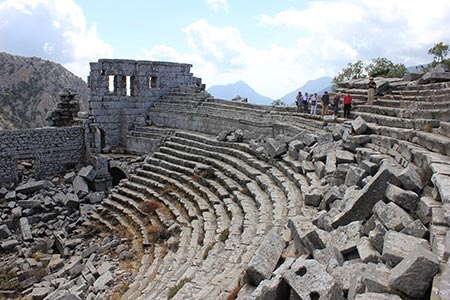 |
The ruins of Perge |
The theatre at termessos |
The following day we headed to the west of Antalya to explore the stunning remains of Termessos, a Hellenistic city built on a high defensible hill. The site has an otherworldly feel, remote and enchanted amongst the forest. The theatre is perched on the edge of a precipice and is remarkably well preserved. We also saw the other town remains including the bouleuterion (town council chamber) and the extensive cemetery. We had some lunch in a very small rural caf� before heading to Karain Cave. Perched on the side of a hill, the cave was inhabited for thousands of years and archaeologists have found the remains of Neanderthal burials. The view from the cave across the plain is wonderful.
The following morning (19th September) we experienced a torrential downpour - it was just as well that we were spending the morning in the excellent Antalya Museum. The museum is famous for its incredible sculpture which came mainly from Perge. We then headed to the airport and flew back to Istanbul, once again checking into the Artefes Hotel in Sultanahmet. The next day we went to see the impressive Dolmabahce Palace, built in the mid 19th Century by Sultan Abdul Mecit. The baroque splendor is overwhelming and it is interesting to see Ataturk's private possessions from when he lived here in the 30s. The afternoon was spent by some exploring the Grand Bazaar and we had our 'last supper' at the Panorama restaurant with fabulous views over Topkapi and Haghia Sophia. Our adventures were over (for some of the group anyway) and a new adventure was about to begin.
Michael Birrell
